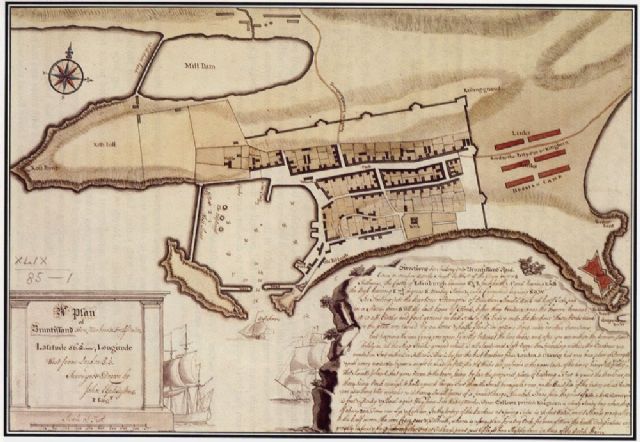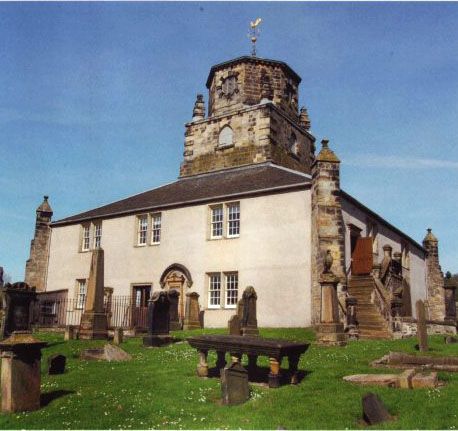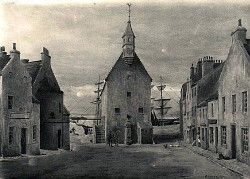A Tale of Two Maps - Burntisland in 1745 and 1746
by Ian Archibald
Ian Archibald is a retired Cartographical Surveyor and Geographical Information System Manager. He is a founder member and Convenor of Burntisland Heritage Trust.
This article was previously published in the May/June 2012 edition of 'History Scotland' magazine.
.jpg)
Elphinstone's map from 1745
Burntisland is fortunate in being the subject of one of the best and earliest examples of detailed town mapping in Scotland. The map was surveyed and drawn by John Elphinstone, eldest son of the 9th lord Elphinstone, and perhaps best known as a military engineer working in Scotland during the period of the 1745 Jacobite uprising. As a commercial mapmaker John Elphinstone produced several notable printed maps. One of Scotland, dated 1745 and titled ‘A new and correctmap of North Britain’, was dedicated to ‘His Royal Highness William, Duke of Cumberland’. This map was supposedly widely used by both sides during the uprising. Little, however, is known about Elphinstone’s later life. He died, seemingly quite suddenly, in 1753, predeceasing his father by some four years. His younger brother, Charles, inherited the title of lord Elphinstone on the latter's death in 1757.
I first came across a black and white print of John Elphinstone’s Burntisland map in John J. Blyth’s book, 'Burntisland: Early History and People'. The map impressed and intrigued me as a remarkable graphic record of that era and research revealed that the map was housed in the British Library. It was described as being part of King George III’s Topographical Collection and had been donated to the nation by George IV. I subsequently ordered up a printed colour copy of the map and this went on public display at the first Burntisland Heritage Summer Exhibition in 1994.

Elphinstone's map from 1746

Burntisland Parish Church
The Admiralty Library map is an outstanding visual record of Burntisland from the mid-18th century period and is packed with information. The map in itself is a work of art. It includes a number of finely drawn sailing vessels both in and out of the harbour. The map title is contained in a cartouche depicting a man playing the pipes, accompanied by a dog, a woman carrying a baby in a cradle with another child, sailing vessels, shells and anchors. The title states: 'A New and Correct Plan of Bruntisland Toun Harbour and Fortifications, Survey’d and drawn by John Elphinstone. Bruntisland in Lat 56 2’ 26” Longit N. from London 3 deg. 3 Min.' There is also a dedication contained in another cartouche showing mythological figures, military items and two men-of-war. The dedication reads: 'To The Most Noble and Right Hon.ble The Lords Commissioners of the Admiralty of Great Brittain. This Plan of the Toun & Harbour of Bruntisland Is Humbly Inscrib'd by Ja.s Oswald Esqr. Provost. John Haxton, Thomas Chrystie, & Ro.t Angus, Baylies of the said Burgh.1745.' The classical scene sits on a plinth which shows a horizontal bar scale graduated at 100ft intervals. The sailing directions and description of the surrounding area are given in two sections. The cartography is very detailed and descriptive although there are many interesting subtle differences between the two maps.
One example of this is the different depictions of the ‘damm head’ which encloses a natural bay on the north west of the map. Here lies a fine and early example of renewable energy. The building shown on the south side of the dam is a tidal mill constructed c.1540. The mill’s waterwheel was powered by a flow of harnessed sea water. The incoming tide enters through flood gates. As the tide began to ebb, these flood gates were closed, thus trapping a reservoir of seawater. Once the tide had ebbed sufficiently, a sluice gate was opened in the mill dam and the out-flowing water was channeled towards an undershot water wheel which supplied the power to turn the milling machinery and the grinding stones. With an average depth of about 3m, this reservoir of water was capable of driving the mill non-stop until the next incoming tide temporarily halted operations. In this fashion, the mill could drive for approximately twelve hours per day in two six hour shifts running on nothing more than gravity of flowing water. Today there are little remains of the tidal mill building which now lies adjacent to reclaimed land approximately 400m from the sea. However, the Sea Mill area was captured for posterity by artist Andrew Young in his 1921 painting (pictured right).
Principal buildings such as the tollbooth (demolished in 1843), the ancient castle and the distinctively square church are all shown on the Admiralty map in blue (and are pictured, left to right, below). The parish church dates back to 1594 and is one of Burntisland’s hidden treasures. It is the oldest post-reformation church in Scotland still in regular use. It was here in 1601 that King James VI of Scotland proposed a new translation of the Bible. Rossend Castle standing on an elevated position overlooking the harbour also has an interesting history. The castle was saved from demolition at the last minute in the 1970s. It was sold to architects, who carried out a sympathetic conversion to offices.This map also shows in red a small intriguing feature below and to the west of the castle, annotated ‘Half Moon’. It is believed that this was the name given to one of the batteries which formed part of the coastal defences.
.jpg)
Sea Mill
From 1548 to 1715 Burntisland was on five occasions subjected to attacks by sea. It is hardly surprising therefore that both maps show two coastal forts. One of the attacks by Cromwell lasted for several days. At this time the town was completely enclosed and armed with about 40 guns. Its possession was absolutely essential to Cromwell, and after its surrender to him it endured the grip of military rule for nine years. When the English soldiers and tax gatherers departed, the town must have hoped for a breathing space in which to recover trade. Unfortunately the rest was short lived, as Charles II went to war with Holland in 1665.
Reference to the Dutch War is made on the sailing directions contained on both maps. Late in April 1667 a fleet of 30 sails arrived at the mouth of the Firth and on both sides of the Forth there was a hasty mustering of militia men. Fifteen Dutch men-of war entered Burntisland roads and promptly brought their guns in to play against the town. In the space of three hours the Dutch were said to have fired over 500 shots. A full report of the event was given in the London Gazette. The final extract reads: 'Edinburgh, May 3. Since the late appearance of the Dutch squadron before Burnt Island, we have heard no further news of them, the Guns they fired had onely this effect, that it drew the people together in great numbers; who, if there had been occasion, were ready and very eager to have entertained them, giving by this their ready appearance, a sufficient testimony of their cheerfulness and courage to defend their country against all invaders.' Fine words indeed.
No doubt the local militiamen responded with guns from the forts shown on both of the maps. One of these is on the headland and the other is the triangular shaped fort to the east of the harbour entrance. They may also have been located on the island to the west of the harbour entrance. Here the Admiralty map reveals another surprise related to the town’s fortifications. There is the clear outline of what appears to be another fortification covering almost the full extent of the island.
The wall feature enclosing the town also came up with a revealing annotation along the northern ‘wall’ which clearly states ‘Lines cast up against O.Cromwell’. This certainly suggests earthen defences. It explains why nothing was left to find when the excavation was carried out by the Archaeological Unit. All of the remains had been ploughed away.
Almost at the same time an extract from the Burntisland Council minute dated 9 April 1745 came to light recording the reasons and the cost of producing this first map.
'Baillie Chrystie laid before the Councill a plan of the Town and Harbour of Burntisland drawn by the Master of Elphinstone and prescribed to the Lords of the Admiralty which he proposed to Carry to London with him to be Laid by Mr Oswald before their Lordships the better to Explain and Inforce the application to be made to them for granting money for the Repairing the harbour and making Docks therein and at the Same time produced an accompt of Expenses ammounting to five pound 8 shillings and threepence halfpenny Sterling incurrd in procuring the foresaid plan of all which the Council approves and appoints Baillie Chrystie to Sign a Warrand or precept for the Clerk to pay the said Expenses.'
From this town minute it clarified why the Admiralty map was produced. But what about the one in the British Library? This map is much less detailed and shown at a smaller scale. There is however the additional feature shown as the ‘Hessian Camp’ on the Links. These troops were held ‘in reserve’ by the Duke of Cumberland.
There is a suggestion that John Elphinstone made this second copy for the duke. Soon after the battle of Culloden in 1746 the duke asked all of his military commanders and engineers to submit every document relating to the campaign. The six Hessian regiments were certainly part of this and although they were not called into action they were held in readiness in Burntisland. They eventually departed from the town in June 1746 and the record of their departure is recorded in the town minutes on 30 June: 'Memo sent to the Commissioners of the Navy relating to the Dammages Done to the harbour by the Transport Ships When the Hessian troops were Embarked – to be repaired at the Crown’s expense.' This is further confirmed from the Navy Board Catalogue of the National Archives: 'Thomas Corbett. Mr. Thames, reporting from Leith, says the six regiments of Hessians are to embark at Burntisland on the next spring tide. All the ships from Newcastle and Inverness will be employed. He proposes to take the Providence to serve as a hospital. Date: 1746.'
Prior to being held in the British Library the map was part of King George III’s collection. As the Duke of Cumberland was the third son of George II it is probable that the information he collected became part of the collection and was passed ‘down the line’.
The Admiralty Library map is a valuable addition to Burntisland Heritage Trust’s growing collection of images and material. When I asked the curator in Portsmouth whether there would be any reproduction costs for the print she came back with an interesting and agreeable response. She said: 'Considering that the people of Burntisland paid the costs for the map to be done in 1745 I think we can waive the charge on this occasion.'

Old Tolbooth
Map Specifications
| Admiralty Map | British Library Map | |
| Imperial scale | 1” to 185’ | 1” to 420’ |
| Representative Fraction Scale | 1/2220 | 1/5040 |
| Dimensions of map | 50 x 72 cm | 22 x 33 cm |
| Date | 1745 | None |

